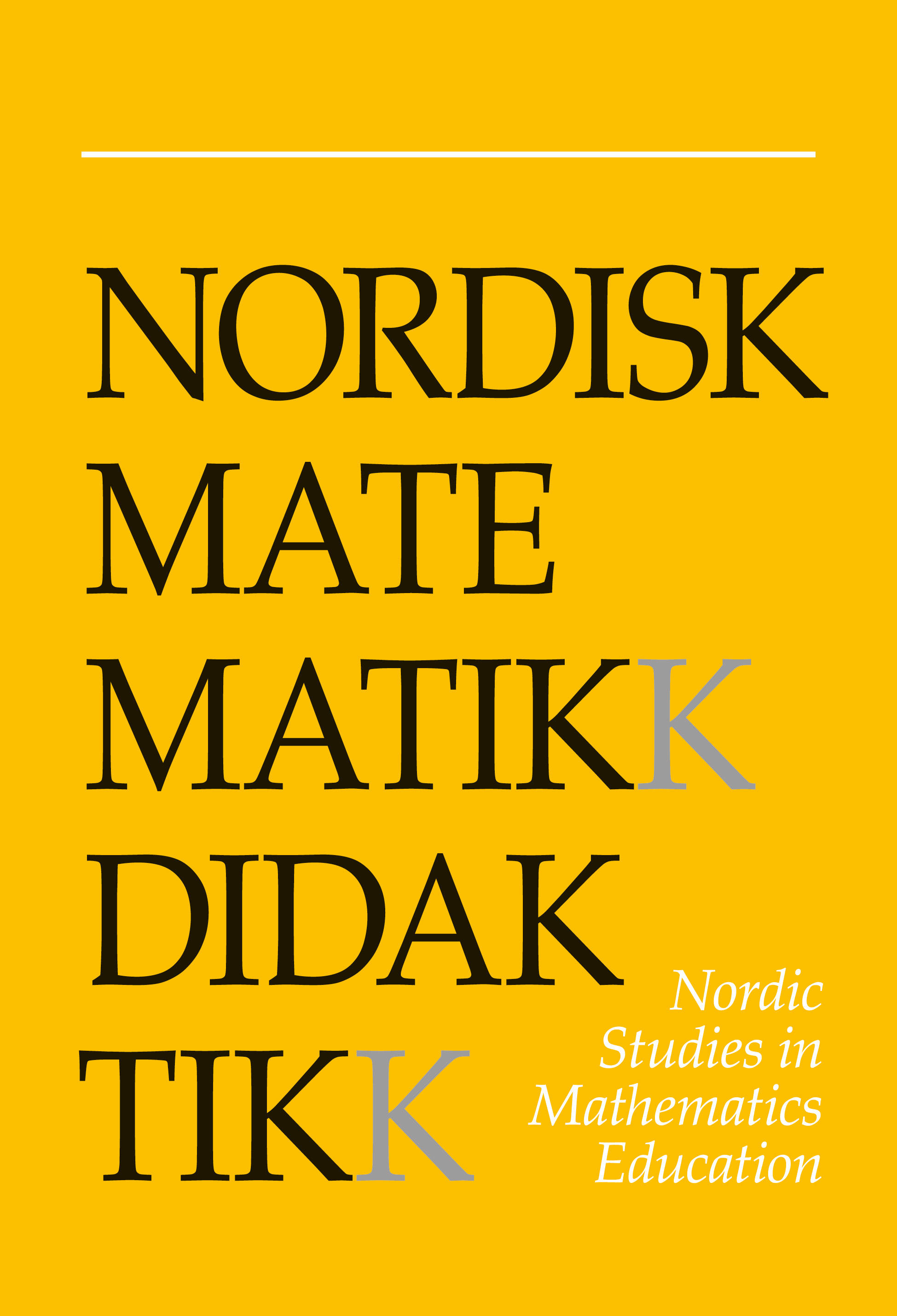Lærerstudenters matematiske tenkning og utvikling i e n sosial kontekst – Problemløsning i smågrupper
DOI:
https://doi.org/10.7146/nomad.v6i2.146642Abstract
Artikkelen er skrevet på bakgrunn av hovedoppgaven 'Problemløsningsprosesser i geometri. Lærerstudenters samarbeid i smågrupper: En dialogisk tilnærming' (Bjuland, 1997). Målet er å identifisere hvordan studenters matematiske forståelse utvikler seg i en sosial sammenheng og ved bruk av matematisk språk i smågruppedialog. Artikkelen introduserer det teoretiske bakgrunnsmaterialet som består av fem hovedområder: problemløsning, læring gjennom samarbeid (L G. S.), affektive sider, klasseromsforskning og sosial og kulturelle sider. En etnografisk tilnærming har vært den grunnleggende metoden for innsamlingen av det empiriske materialet, mens det er brukt en 'dialogisk tilnærming' for å tolke og analysere gruppesamtalen. Artikkelen fokuserer på fire episoder fra gruppesamtalen som gir et inntrykk av studentenes matematiske tenkning og utvikling, studentenes sosiale ferdigheter, et av studentenes matematiske gjennombrudd i løsningsprosessen og studentenes evne til å reflektere over gruppesamarbeidet. Resultatene fra analysen av gruppediskusjonen viser at studentene har utviklet sin forståelse i matematikk og sine sosiale ferdigheter. Det er et sterkt samspill mellom faglige og sosiale ferdigheter formidlet gjennom språket.
References
Alrø, H. & Skovsmose, O. (1994). On the right track. Institute for Electronic Systems, Aalborg University.
Barkatsas, A.N. & Hunting, R. (1996). A review of recent research on cognitive, meta-cognitive and affective aspects of problem solving. Nordic Studies in Mathematics Education, 4, (4), 7-30.
Bauerfeld, H. (1980). Hidden dimensions in the so-called reality of a mathematics classroom. Educational Studies in Mathematics, 11, (1), 23-41. https://doi.org/10.1007/BF00369158
Bishop, A.(1988). Mathematics education in its cultural context. Educational Studies in Mathematics, 19, 179-191. https://doi.org/10.1007/BF00751231
Bjuland, R. (1997). Problemløsningsprosesser i geometri. Lærerstudenters samarbeid i smågrupper: En dialogisk tilnærming.Hovedoppgave ved Høgskolen i Agder, Norge.
Borgersen, H.E. (1994). Open ended problem solving in geometry. Nordisk matematikk- didaktikk ,2,(2), 6-35.
Carraher, T.N., Carraher, D.& Schliemann, A.D. (1985). Mathematics in the streets and in schools. British Journal of Developmental Psychology, 3, 21-29. https://doi.org/10.1111/j.2044-835X.1985.tb00951.x
Cestari, M.L. (1997). Abandoning some certainties: The social construction of knowledge in the mathematics classroom. In A. Tjeldvoll & I.S. Holmesland (Eds.). Globalization and Education. Essays on Quality of Equality. University of Oslo, Institute for Educational Research. Report no. 10.
Cestari, M.L. (1998). Teacher/Student communication in traditional and constructivist approaches to teaching. In M. B. Bussi & A. Sierpinska & H. Steinbring (Eds.), Language and communication in the mathematics classroom, 155-166. Washington: NCTM.
D'Ambrosio, U. (1991). Etnomathematics and its place in the history and pedagogy of mathematics.InM.Harris(Ed.),School, mathematicsandwork,15-25.London:TheFalmer Press.
Deutsch, M.(1949). A theory of cooperation and competition. Human Relations, 2, 129-152. https://doi.org/10.1177/001872674900200204
Digre, L. & Solerød, E. (1993).Samarbeidslæring i matematikk. Halden Lærerhøgskole, Norge.
Grouws, D.A. & Cramer, K. (1989). Teaching practices and student affect in problem-solving lessons of select junior-high mathematics teachers. In D.B.McLeod & V.M.Adams (Eds.), Affect and mathematical problem solving, 149-161. New York, NY: Springer Verlag. https://doi.org/10.1007/978-1-4612-3614-6_10
Haugaløkken, O.K. (1987). Elevsamarbeid og holdninger i klasserommet. Hovedoppgave, Pedagogisk Institutt, Universitetet i Trondheim, Norge.
Johnsen, V. (1996). Hva er en vinkel? Nordisk matematikkdidaktikk, 4, (1), 25-49.
Johnson, D.W.& Johnson, R.T.(1990). Using cooperative learning in math. In N. Davidson (Ed.), Cooperative learning in mathematics. A handbook for teachers, 103-125. Menlo Park: Addison Wesley.
Kirke-, utdannings- og forskningsdepartementet (1997). Læreplanverketfor den 10-årige Grunnskolen.Nasjonalt læremiddelsenter.
Lampert, M. (1990). When the problem is not the question, and the solution is not the answer: Mathematical knowing and teaching. American Educational Research Journal. 27, 29-63. https://doi.org/10.2307/1163068
Lave, J., Smith, S. & Butler, M. (1989). Problem solving as everyday experience. In R.I.Charles & E.A.Silver (Eds.), The teaching and assessing of mathematical problem solving, 61-81. Reston, VA: NCTM.
Lave, J. & Wenger, E. (1991). Situated learning. Legitimate peripheral participation. Cambridge: Cambridge University Press. https://doi.org/10.1017/CBO9780511815355
Lester, F.K. (1994). Musings about mathematical problem-solving research 1970-1994. Journal for Research in Mathematics Education, 25, (6), 660-675. https://doi.org/10.2307/749578
Markova, I. (1990). A three-step process as a unit of analysis in dialogue. In I. Markova & K. Foppa (Eds.), The Dynamics of Dialogue, 129-146. New York, NY: Harvester Wheatsheaf.
McLeod, D.B. (1992). Research in affect in mathematics education: A reconceptualization. In D.G.Grouws (Ed.), Handbook of research on mathematics teaching and learning, 557- 596. New York: Macmillan.
Pehkonen, E & Törner, G. (1996). Mathematical Beliefs and Different Aspects of their Meaning. ZDM,4, 101-108.
Polya, G. (1945; 2nd edition 1957). How to solve it. Princeton, NJ: Princeton University Press.
Schoenfeld, A.H. (1985). Mathematical problem solving. Orlando, FL: Academic Press.
Schoenfeld, A.H. (1992). Learning to think mathematically: Problem solving, metacognition and sense making in mathematics. In D.A. Grouws (Ed.), Handbook of research on mathematics teaching and learning, 334-370. New York, NY: Macmillan.
Schoenfeld, A.H. (1993). Teaching mathematical thinking and problem solving. Sånn, Ja! Rapport fra en konferanse om matematikkdidaktikk og kvinner i matematiske fag. (Arbeidsnotat 2/93, s. 67-89), Oslo: Norges forskningsråd, Avd. NAVF Sekretariatet for kvinneforskning.
Silver, E.A. (1985). Research on teaching mathematical problem solving: Some underrepresented themes and directions. In E.A. Silver (Ed.), Teaching and learning mathematical problem solving: Multiples research perspectives, 247-266, Hillsdale, NJ: Lawrence Erlbaum.
Silver, E.A. (1987). Foundations of cognitive theory and research for mathematics problem solving instruction. In A. Schoenfeld (Ed.), Cognitivescience and mathematics education, 33-60. Hillsdale, NJ: Lawrence Erlbaum.
Silver, E.A. (1994). On mathematical problem solving. For the Learning of Mathematics, 14, (1), 19-28.
Svege, E. (1996). Affektive sider ved undervisning og studenters læring av matematikk. Hovedoppgave ved Høgskolen i Agder, Norge.
Svege, E. (1997). Studenters forestillinger, holdninger og følelser overfor matematikk. Nordisk matematikkdidaktikk, 5, (2), 25-55.
Downloads
Published
How to Cite
Issue
Section
License

This work is licensed under a Creative Commons Attribution-NonCommercial-ShareAlike 4.0 International License.



